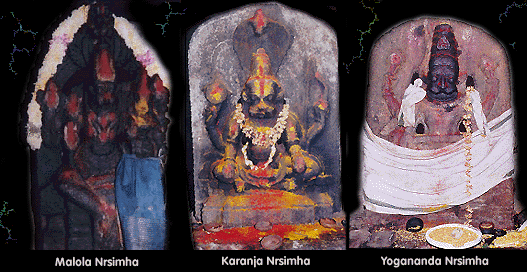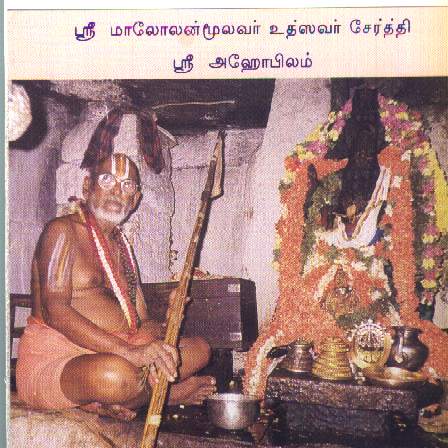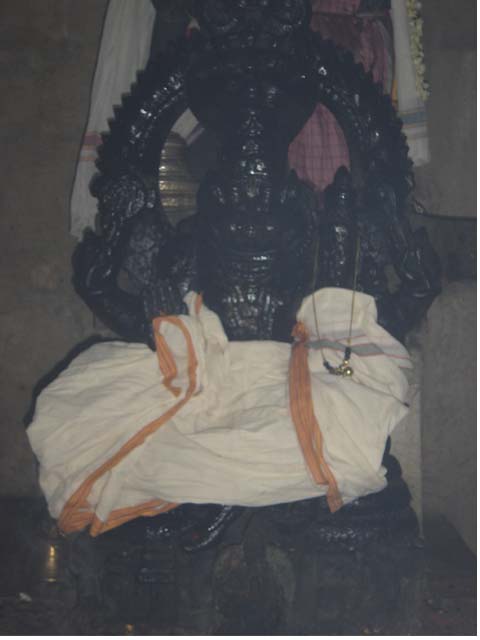Today’s [30th April 2008] lecture is from Thiruvelliankudi. Here the Lord is gracing as Sri Rama. In the four yugs this place was called by different names. In Kritha yug it was called Brahmapuram; in Thretha yug it was Parasarapuram; in Dwapara yug it was Indrapuram; and now in Kaliyug it is also called Bhargavapuram. Sri Rama is gracing in the reclining pose, which is rare. The sthala vruksham or temple tree is sevvazhai in Tamil [செவ்வாழை] or the red variety banana tree. In Sanskrit it is kathali pala tree. Pushpalaka vimanam is the canopy here. Thayar is Sri Maragathavalli Nachiyar. The Lord is called Sri Kola villi Raman. Though the temple is in a small village, its fame is very great. We can get the reason for the name of this Kshetram from puranas and from Alwars’ poems. Thirumangai Alwar has dedicated the 4.10, entire decade for this Kshetram in his Periya Thirumozhi. He mentions the name of the Lord as Kolavilliraman. Velli [வெள்ளி] in Tamil indicates Sukra [Venus] planet. Indra was ruling the three worlds Bhoo, Bhuva and Suva. Emperor Bali defeated Indra and captured his entire kingdom. Indra’s mother was very much grieved and prayed to the Lord and observed certain fasting [vratham]. She was blessed with the Lord Himself being born as the Younger brother [Upendra]- Sri Vamana. In the guise of a bachelor and with deerskin on His shoulders the Lord arrived at the place where Emperor Bali was performing yagna. He demanded ground measuring three steps by Him, which was readily agreed by the Emperor. What can be that area, we might think, but the Lord is capable of doing beyond our imagination and that is what was to happen. Normally, any such grant has to be authenticated by pronouncement with water flowing from the hands. So Bali took the water pot to make the promise. His Guru was Sukracharya and he knew that the Lord had come in disguise to take away all wealth of Bali; and to prevent that Sukracharya in a bee form went and blocked the hole from which water was to flow to solemnize the promise. But the Lord knew the cause and so like dirt being removed in any block, He used a grass [dharba] to clear the block. It hurt one of he eyes of Sukracharya, in the guise of a bee, and with pain the bee fell out and water flowed, and the promise was legalized. Sri Vamana took the gigantic Sri Trivikrama form and in one step measured all the worlds and in the second step measured all the upper worlds and asked Bali, which was the place for the third step. Humbled, Bali bowed down and offered his head for placing the third step and the Lord placing His foot on his head pushed him to live in the nether worlds. Sukracharya wanted to regain his lost eye and wandered all over. The Lord is the eye for all and so Sukracharya finally landed in this Kshetram and for 48 days –one mandalam- prayed sincerely and regained his lost eyesight. The Alwar narrates this incident. This place became from then on Thiruvelliankudi, after Sukracharya. Many devotees come to this place for regaining eyesight and other eye problems. Near the Lord there is a lamp called Netra deepam and is never extinguished; that is, it is lit all 24 hours, 365 days, continuously. With good eyesight we gain more wisdom. Now we will see the Fist sloka of Chapter 8. The first two slokas are the doubts or questions raised by Arjuna to clarify what Sri Krishna told in the slokas 29 and 30 of Chapter 7. Now to slokas of Chapter 8:
arjuna uvaca
kim tad brahma kim adhyatmam
kim karma purushottama
adhibhutam ca kim proktam
adhidaivam kim ucyate
"Arjuna inquired: O my Lord, O Supreme Person, what is Brahman? What is the self? What are fruitive activities? What is this material manifestation? And what are the demigods? Please explain this to me."
Arjuna asks what the three types of devotees – Aiswaryarti, Kaivalyarti and Bhagavallabharti- should practice and know. Kim tad brahma = which is brahmam?, kimadyatma = which is adyatma? Kimkarma = which is karma?, Purushottama = Sri Krishna, [to be followed by kaivalyarti type of devotees]. We will see he details of reply in the later slokas. Here only the questions are posed. Adibhuta kim= which is atibhutha? Adideivamkim = which is adi deivam?, these are to be known by aiswaryarti type of devotees. These include pleasures of this world as well as in heaven. In this sloka 1, thus the requirements of kaivalyarti and aiswaryarti are sought for by Arjuna. Here brahmam is not the Paramatma, but the objective of kaivalyarti. In sloka 2:
adhiyajnah katham ko ’tra
dehe ’smin madhusudana
prayana-kale ca katham
jneyo ’si niyatatmabhih
"Who is the Lord of sacrifice, and how does He live in the body, O Madhusudana? And how can those engaged in devotional service know You at the time of death?"
Adi yagna = which is called ati yagna? Atra = here, asmin = in this, dehe = body. Body here does not mean the body of Arjuna or others; but means all the gods and others who are all body of the Lord [He is the soul for all]. So which is called adi yagna in these gods? Katham adi yagna = how it is called ati yagna? That is how this quality of ati yagnam has come on these gods and which is called ati yagnam. This question has to be clarified for all the three types of devotees. It is a common clarification. Prayana kale = in the last moments [of life’s journey], katam neyosi = how You [Sri Krishna] are to be worshiped?, niyatam atmaabhi = even by those who have controlled the mind and organs. All the three types of devotees, when they are about to die or when their atman is going to leave respective bodies, how are they to worship the Lord?







